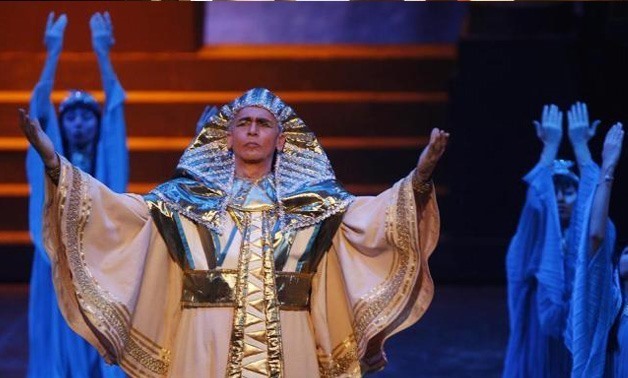
File - Opera Aida.
CAIRO – 13 July 2019: In an attempt to promote tourism in that historical city, Luxor will organise “Opera Aida” show in the famed Mortuary Temple of Hatshepsut on October 26,28.
Luxor launched marketing campaign for this show in a number of European and Asian countries.
Opera Aida consists of four acts that embody the conflict between duties and passion through telling the love story of the Ethiopian prisoner Aida and the Commander of the Egyptian Army Radamis.
Radamis is sentenced to death after the Pharaoh knows that he was trying to escape with Aida to Ethiopia.
Manuscripts of Opera Aida were found in the Nile Valley, written by the French Egyptologist Auguste Mariette, who was commissioned by Khedive Ismail Pasha.
Giuseppe Verdi composed “Opera Aida” for 150,000 gold francs in 1870, while Khedive Ismail Pasha had the Khedivial Opera House built in only six months to host the Opening of the Suez Canal celebrations.
But due to the late arrival of the decorations and clothes of the performance from Paris, the show was not held, and instead “Opera Rigoletto” was performed in the celebrations by an international Italian troupe.
There is a popular belief that, at the beginning, Verdi refused the Khedive’s offered commission to compose “Aida”. It is also believed that he changed his mind after knowing that the Khedive had decided to offer that commission to another composer, according to San Francisco Opera Association’s official website.
Although “Aida” is based on a love story that took place in the Egyptian Pharaonic era, it successfully attracted opera fans from all over the world. “Opera Aida” has unique human, artistic and historical values that led the international opera community to hold this opera in special regard.
“Aida” shows how love can be forbidden when the beautiful Ethiopian Princess Aida gets stuck between her love for the Egyptian leader Radamis and between her love for her father and country.
The Egyptian king’s daughter, who also loves Radamis, imprisons Aida to be her slave. Led by Aida’s father, Egypt’s Ethiopian enemies head to invade the country, which led to the father’s imprisonment to meet his daughter in prison.
According to Aida’s father’s demand, Radamis leaks a military secret, which leads to his burial while still alive. Yet he is shocked when he finds Aida in the tomb, waiting to die with him.
Through painting a portrait of brutal war between love and duty, Verdi explores the different aspects of a work in which individuals’ destinies are being shaped.
It may seem that, in this opera masterpiece, Egypt’s history is the only major target to be personified. Verdi infuses the main characters with a pitiful humanity, highlighting many human factors, such as passions, forced destinies, gods, ego and bad luck.
By premiering first in Milan specifically and by choosing the right voices, Verdi succeeded in exploring emotions in depth through his convincing music.
Studying Egypt’s history, music and geography, Verdi composed varied Egyptian melodies harmonically, which was clear in the opening of the third act with the Nile scene. The composer had developed an extraordinarily clever ear for orchestral effects and theatrical atmosphere.
Although “Aida” portrays a significant stage in Egypt’s history, Verdi was very much affected by the political change in Italy, in which nationalists were fighting to unify the country. Verdi was known for reflecting the political instabilities all over the world in his operas, becoming the “Composer of the Revolution”.
Also at the time of “Aida”, Napoleon III launched a war on the German kingdom, which led to the loss of the regions of Alsace and Lorraine.
After premiering in Egypt and Milan, “Aida” premiered in many countries starting from 1873, such as Argentina, the U.S., Germany, Spain, Austria and Poland, among numerous other countries.
Verdi is an acclaimed Italian composer; his first opera, “Oberto”, premiered at La Scala in Milan and was well established. During this period known as his “galley years”, Verdi created most of his remarkable works, such as “Rigoletto” (1851), “Il Trovatore” (1853) and “La Traviata” (1853), which remain remarkable pieces of opera history today.
He ended his artistic journey by composing two plays by Shakespeare – “Otello” (1887) and “Falstaff” (1893) – which successfully premiered, leaving a significant print in international opera history.

Comments
Leave a Comment